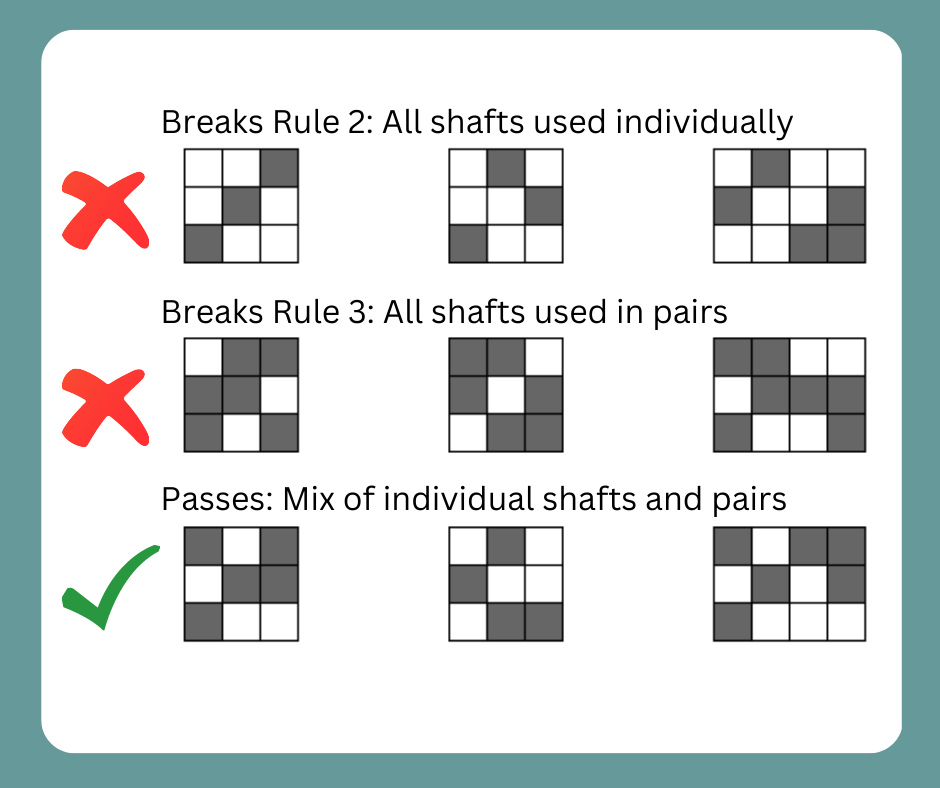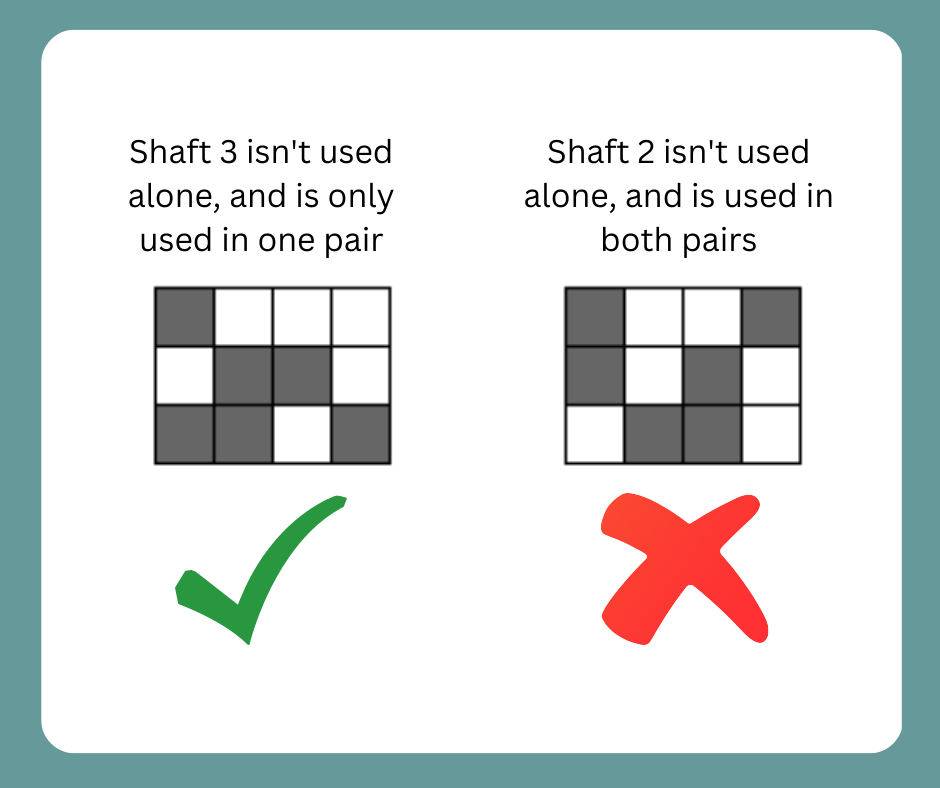How can you tell if you can weave a 3 shaft draft with just 1 pick up stick?
draftspick-updeep diveDesigns using one pick up stick are a fun way to go beyond plain weave on your rigid heddle loom. Rigid heddle weavers have come up with a wide range of patterns using this constraint, but there are some patterns designed for 3 shaft looms that can also be woven this way.
To be clear, there's lots you can do by using more than one stick, or, if you only physically have one stick, moving it around, but, leaving a single stick in place is the simplest kind of pick up work. This post is partly an exercise in more deeply understanding the relationship between pick up patterns and shafts!
I first dove into the relationship between sticks and shafts last summer in my post “How many shafts would you need to weave that pick up pattern?”. The constraint turns out to be the combinations of shafts used in the pattern, which is reflected in the tie-up section of a draft.
To summarize the one pick up stick portion of that post, with one stick (left in place), your 3 ‘shafts’ are:
- Holes
- Picked Up Slots
- Not Picked Up Slots
And your possible shaft combinations (sheds) are:
- Up: Holes
- Down: Picked Up Slots + Not Picked Up Slots (aka all slot threads)
- Neutral + Stick: Picked Up Slots
- Up and Stick: Holes + Picked Up Slots
This means you can't use these combinations:
- Not Picked Up Slots
- Holes + Not Picked Up Slots
I haven’t assigned shaft numbers here, because it turns out that will vary based on the draft.
Another way of phrasing that is that the shaft representing the threads that aren’t picked up can only be used in combination with the threads that are picked up.
A quick refresher on drafts #
A draft is a kind of diagram commonly used by shaft loom weavers. It includes information on which threads are on which shaft (in the threading section), which shafts are grouped together to make different sheds (in the tie-up section), and which order the sheds are used to make the fabric (in the treadling section). For more detail, you can check out How to Read a Weaving Draft on Gist Yarn’s blog, or Liz Gipson’s video, Shafts, Drafts, and the Rigid Heddle.

For the purposes of this post, I’m talking about drafts for floor looms, which have a tie up section and only use one treadle per weft row. This is the default format shown by Handweaving.net, for example. There are some other formats for drafts, and they can be converted manually or using weaving software.
So how can I tell if I can weave it with one stick? #
To tell if you can weave a draft with one pick up stick, first of all, it has to be a 3 shaft draft. It can sometimes be possible to convert a draft using more shafts to a 3 shaft draft, but that’s well beyond the scope of this post!
Start by looking at the tie up. Each column in the tie-up is a combination of shafts that are used in the draft. If any columns are duplicated, remove them (sometimes they are duplicated to make an easier to remember treadling order). If you have less than 3 columns left, then, the draft is effectively a 2 shaft draft and doesn’t need a stick, or, it won’t produce a stable fabric (a shaft is either always used or never used). Otherwise, work through these 4 rules:
- If there’s more than 4 columns, the draft can’t be woven with 1 stick.
- If more than 2 columns use only one shaft, the draft can’t be woven with 1 stick.
- If more than 2 columns use two shafts together, the draft can’t be woven with 1 stick.
- If there are 4 treadles, there will be 1 shaft that isn’t used alone. If it’s used in both paired shafts, the draft can’t be woven with 1 stick.
If you've passed all of those checks, then, the draft can be woven using just one pick up stick left in place.
So what does that look like?


As it turns out, most 3 shaft drafts are excluded by the first three rules, and they are easiest to spot. These rules filter out anything twill based, which either use each shaft individually, or, each shaft in a pair (or both), along with a number of other patterns. Rule 4 is more subtle. A tie-up that uses 4 treadles and passes rule 4 will have one shaft that’s used in 3 of the 4 shed configurations, and this turns out to be pretty rare in shaft loom drafts.
There are a number of drafts on Handweaving.net that use three treadles and pass these rules, but ones using 4 treadles are quite rare. #45296 and #61347 are two that I have found - and they both have no others using the same tie up. But in the rigid heddle world this is a common type of pattern - it’s simply a pick up pattern that uses the stick in both positions. Give people different constraints, and they’ll come up with different designs!
Now, you’ll find yourself asking “How do I work out how to weave a 3 shaft draft with 1 stick”. Stay tuned for my next post!
Check out Not So Rigid Designer, the online weaving software for rigid heddle loom weavers!
